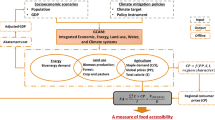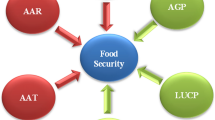Abstract
Food security in China, the world’s most populous country, has long been a concern because of the challenges of population growth, water shortages, and loss of cropland through urbanization, soil degradation, and climate change. Here, we present an integrated analysis of China’s food demand and supply under IPCC Special Report on Emissions Scenarios A1, A2, B1, and B2 in 2020, 2050, and 2080, based on official statistics and future development scenarios. Our analysis accounts for future socioeconomic, technological, and resource developments, as well the impact of climate change. We present a covariant relationship between changes in cereal productivity due to climate change and the cereal harvest area required to satisfy China’s food demand. We also estimated the effects of changing harvested areas on the productivity required to satisfy the food demand; of productivity changes due to climate change on the harvest area required to satisfy food demand; and of productivity and land use changes on the population at risk of undernutrition. China could be able to feed herself without disturbing the global food market in the twenty-first century, but whether the government will choose self-sufficiency or increased food imports may depend on the cost of change, which remains unknown.
Similar content being viewed by others
References
Alexandratos N (1999) World food and agriculture: outlook for the medium and longer term. Proc Natl Acad Sci USA 96:5908–5914
Brown LR (1995) Who will feed China? Norton, New York
CHINAGRO (2005) Policy decision support for sustainable adaptation of China’s agriculture to globalization. www.iiasa.ac.at/Research/LUC/chinagro.html
Döös BR (2002) The problem of predicting global food production. Ambio 31:417–424
Easterling WE, Aggarwal PK, Batima P, Brander KM, Erda L, Howden SM, Kirilenko A, Morton J, Soussana JF, Schmidhuber J, Tubiello FN (2007) Food, fibre and forest products. Climate change 2007: impacts, adaptation and vulnerability. In: Parry ML, Canziani OF, Palutikof JP, van der Linden PJ, Hanson CE (eds) Contribution of Working Group II to the fourth assessment report of the intergovernmental panel on climate change. Cambridge University Press, Cambridge, UK, pp 273–313
Ewert F, van Oijen M, Porter JR (1999) Simulation of growth and development processes of spring wheat in response to CO2 and ozone for different sites and years in Europe using mechanistic crop simulation models. Eur J Agron 10:231–247
Ewert F, Rounsevell MDA, Reginster I, Metzger MJ, Leemans R (2005) Future scenarios of European agricultural land use I. Estimating changes in crop productivity. Agric Ecosyst Environ 107:101–116
FAO (2001) Agriculture towards 2015/2030, Technical Interim Report. United Nations Food and Agricultural Organization, Rome, Italy http://www.fao.org/WAICENT/FAOINFO/ECONOMIC/esd/at2015/chapter4.pdf
FAO (2004) FAOSTAT data: statistical database of the food and agricultural organization of the United Nations. http://apps.fao.org
Gaffin SR, Rosenzweig C, Xing X, Yetman G (2004) Downscaling and geo-spatial gridding of socio-economic projections from the IPCC Special Report on Emissions Scenarios (SRES). Glob Environ Change A 14:105–123
Heilig GK (1999) Can China feed itself?—a system for evaluation of policy options. Laxenburg, IIASA. http://www.iiasa.ac.at/Research/LUC/ChinaFood/index_m.htm
Huang J, Carl P, Scott R (2002) Enhancing the crops to feed the poor. Nature 418:678–684
IMAGE-team (2001) The IMAGE 2.2 implementation of the SRES scenarios: a comprehensive analysis of emissions, climate change and impacts in the 21st century. National Institute of Public Health and the Environment (RIVM), Bilthoven, The Netherlands
Lin E, Xiong W, Ju H, Xu Y, Li Y, Bai L, Xie L (2005) Climate change impacts on crop yield and quality with CO2 fertilization in China. Phil Trans R Soc B 360:2149–2154
Liu J, Liu M, Tian H, Zhuang D, Zhang Z, Zhang W, Tang X, Deng X (2005a) Spatial and temporal patterns of China’s cropland during 1990–2000: an analysis based on Landsat TM data. Remote Sens Environ 98:442–456
Liu J, Zhan J, Deng X (2005b) The spatial-temporal patterns and driving forces of urban land expansion in China during the economic reform era. Ambio 34:450–455
Morita T, Matsuoka Y, Penna I, Kainuma M (1994) Global carbon dioxide emission scenarios and their basic assumptions: 1994 survey. CGER-1011-94, Center for Global Environmental Research, National Institute for Environmental Studies, Tsukuba, Japan
Nakićenović N, Swart R (eds) (2000) Special report on emissions scenarios. Cambridge University Press, Cambridge, UK
National Bureau of Statistics of China (2005) China statistic yearbook 2005. China Statistics Press, Beijing China
Parry ML, Rosenzweig C, Iglesias A, Livermore M, Fischer G (2004) Effects of climate change on global food production under SRES emissions and socio-economic scenarios. Glob Environ Change 14:53–67
Rosegrant MW, Paisner MS, Meijer S, Witcover J (2001) Global food projections to 2020: emerging trends and alternative futures. The international food policy research institute, Washington D.C., USA, p 206
Rounsevell MDA, Ewert F, Reginster I, Leemans R, Carter TR (2005) Future scenarios of European agricultural land use: II. Projecting changes in cropland and grassland. Agric Ecosyst Environ 107:117–135
Tao F, Yokozawa M, Hayashi Y, Lin E (2003) Future climate change, the agricultural water resources, and agricultural production in China. Agric Ecosyst Environ 95:203–215
Tao F, Yokozawa M, Zhang Z, Hayashi Y, Grassl H, Fu C (2004) Variability in climatology and agricultural production in China in association with East Asia Monsoon and EL NiÑo southern oscillation. Clim Res 28:23–30
Tao F, Yokozawa M, Hayashi Y, Lin E (2005) A perspective on water resources in China: interactions between climate change and soil degradation. Clim Change 68:169–197
Tao F, Yokozawa M, Xu Y, Hayashi Y, Zhang Z (2006) Climate changes and trends in phenology and yields of field crops in China, 1981–2000. Agric For Meteorol 138:82–92
Tao F, Hayashi Y, Zhang Z, Sakamoto T, Yokozawa M (2008) Global warming, rice production and water use in China: developing a probabilistic assessment. Agric For Meteorol 148:94–110
Tong C, Hall CAS, Wang H (2003) Land use change in rice, wheat and maize production in China (1961–1998). Agric Ecosyst Environ 95:523–536
WRI (2000) World resources 2000–2001, people and ecosystems. World Resources Institute, Washington DC, USA, p 389
Xiong W, Lin E, Ju H, Xu Y (2007) Climate change and critical thresholds in China’s food security. Clim Change 81:205–221
Author information
Authors and Affiliations
Corresponding author
Rights and permissions
About this article
Cite this article
Tao, F., Yokozawa, M., Liu, J. et al. Climate change, land use change, and China’s food security in the twenty-first century: an integrated perspective. Climatic Change 93, 433–445 (2009). https://doi.org/10.1007/s10584-008-9491-0
Received:
Accepted:
Published:
Issue Date:
DOI: https://doi.org/10.1007/s10584-008-9491-0




